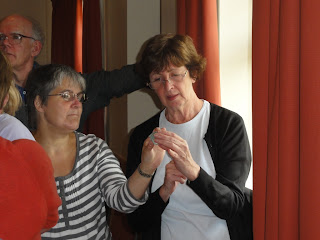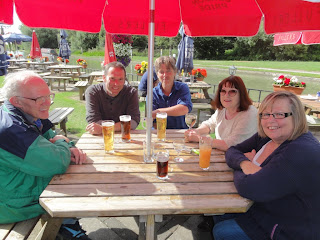The following
Saturday saw us back at the Broadwell Victory Hall for the Roman Pottery and
Roman Small Finds workshops. Both of these workshops were very popular. Jane
Timby had been brought in a couple of weeks ago to assess the finds already
collected. Her report will be made available in due course.
It was a fascinating lecture covering the basics of pottery identification: what can pottery tell us, from what is it made, inclusions, uses etc. She then reported on the Broadwell assemblage. The 3000+ sherds were categorized into late prehistoric, continental Roman imports, regional Romano-British imports, local Roman, Medieval, post medieval and CBM (ceramic building material).
Of the total assemblage, 89% was classed as Roman ware, and 84% of that was grey ware; your common and garden, everyday crockery of the Roman household. Of the Roman imports, she commented that unusually no amphorae had been found, but hopefully that’s still out there to find.
 |
| Jane answering questions on the Broadwell pottery. |
At the end of the session, we were able to look at some of the Broadwell pottery and also at some Jane’s reference collection.
In the afternoon,
we were supposed to have had Ian Meadows come and talk to us, but despite best
laid plans etc, that was not to be and the session was run by Paul Mason and
Bryn. Ian has been responsible for
assessing all our small finds, which has included everything that wasn’t
pottery, including the metal detecting finds. In order to help us understand
and recognize what we may find on our field walking and metal detecting
workshops.
Paul and Bryn had devised a quiz. There were 4 teams of 6 and 4
tables of finds to look at. There were 2 tables of Broadwell finds and 2 tables
of Roman finds from other sites. It was great fun and an invaluable exercise as
it made people think about what they were looking at, and try to identify the
material and possible use of the items.
 |
| Do we know what it is yet? |
 |
| Well, it's Roman! |
 |
| A much need half at the dig pub! |


No comments:
Post a Comment